|
|
|
REPORT Limited Altitude Warm-Up Meet (No season championship points) Lakeville, 19 April 2012 Commentary by Andrew Tickle, photography by Mike Sidwell |
|
| Season Championship Schedule |
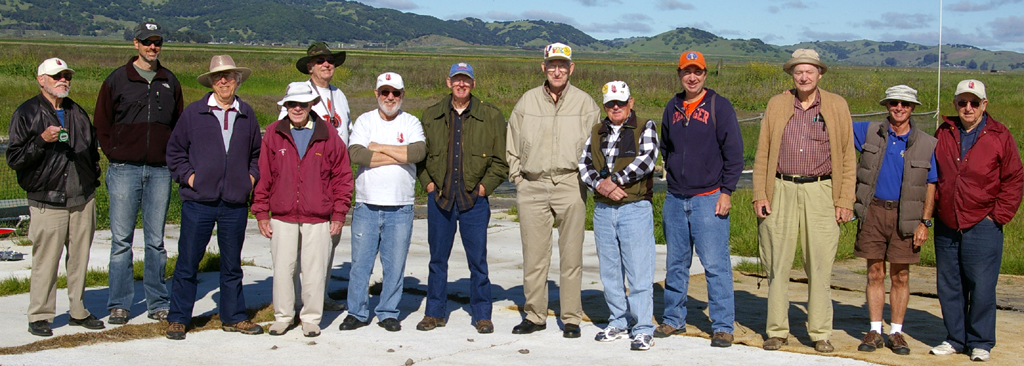 |
| Pilots, timers, helpers, enthusiasts etc. at SAM 27's first limited altitude meet |
Spectacular Show
Five pilots flew 5 rounds each on a typical windy spring day, to try out the SAM 27 limited altitude rules.
They put on a spectacular show for the spectators, starting with a formation takeoff and vertical climb to 200 meters (654 ft.), the altitude cutoff. See Warm-up Rules
Big Thanks to the pilots and timers (who were busier than expected) for performing in Chip's "Voluntary Experiment".
Pilots: Dick Irwin, Greg Huffman, Aric Wilmunder, Chip Buss, Andrew Tickle
Timers: Karl Tulp, Mike Sidwell, Bob Rose, Ed Solenberger, Otto Wiederkehr
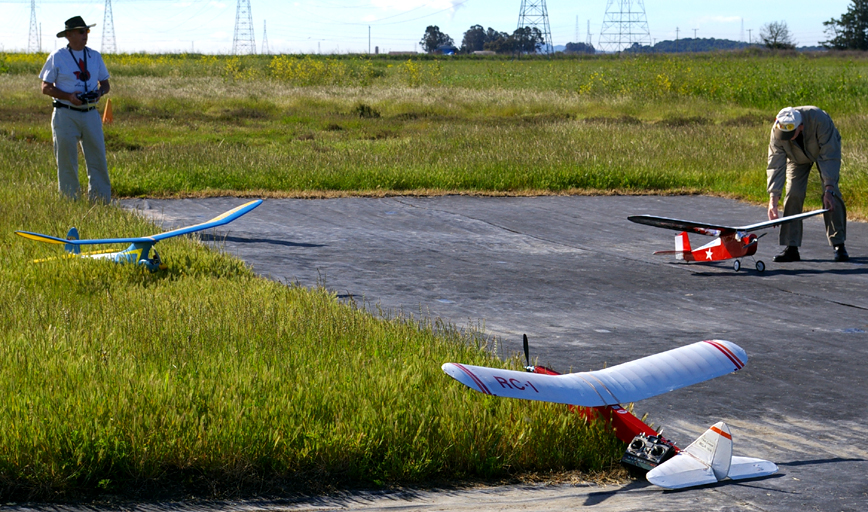 |
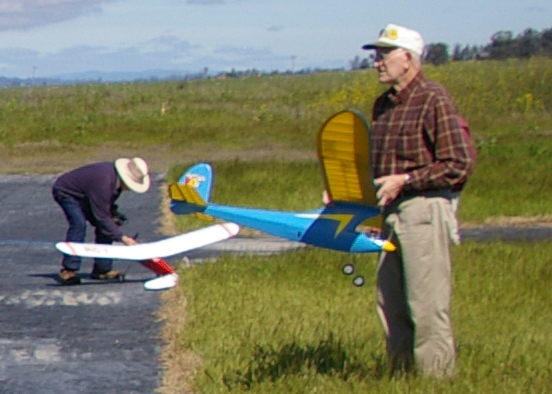 |
| Prior to the first mass takeoff -- checking last minute things. | |
|
How we did the Mass Takeoffs
There was no problem with the formation mass takeoff. But because of the wind strength the planes rolled backwards while waiting to takeoff (should we install brakes?). So the timers volunteered to hold on to the planes on the runway until the moment of takeoff. This solved the takeoff problem completely. |
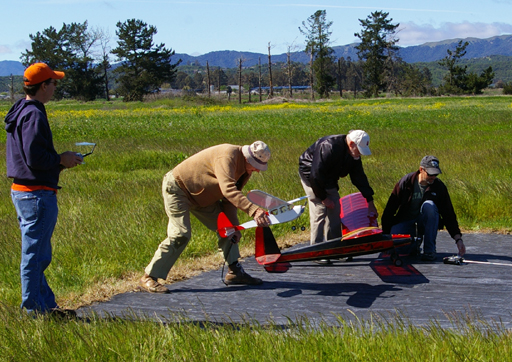 |
| Preparing for the starter's gun at takeoff. Ed is holding back Greg's 108 in. Dallaire against the wind. Otto is placing Aric's 49 in Cleveland Viking into position. These vertical formation climbs, straight up to 200 meters (654) feet, are exciting for pilots and spectators alike. |
|
But there was still another problem to
solve. It was too windy (and and too directly down runway) to
make "diagonal" takeoffs, as we had planned. Everyone had to
take off directly down the runway. This made it hard to clear
the timers by the 25 foot AMA safety margin.
Chip solved this problem by changing from formation takeoff to rapid sequence takeoff. Each pilot had to wait until the runway ahead was clear of timers before taking off. This worked perfectly for the remaining 4 rounds. It also showed how unbelievably fast and agile our timers are. Hand Launch? You Gotta be Joking.... For a warm-up meet, pilots showed good competitive spirit. For a measly 5 point advantage all pilots made takeoffs rather that the (safer?) hand launch. That's all 5 pilots choosing to use their takeoff skills 25 times out of 25 with no problem. Hand launches -- zero! What are those wheels for anyway? Landings -- We got work to do there.. Only seven out of 25 landings were on the runway -- but they were good ones! There were also a number of good ones just short of the runway. The problem was the usual one -- the wind, and setting up the final part of the flight to make both the exact time and the runway. Clearly the landing skills were worth a lot more than the mere 5 points awarded. The soaring purists say the landing points are irrelevant, which is true if you don't score any. But for all-round fliers the question is how well can you really control that plane? Avoiding Landing Congestion There were no landing congestion problems. We used the same rule they use at San Francisco -- after landing on the main runway DO NOT PARK there. Just taxi off smartly or re-takeoff -- what are those motors and wheels for anyway? A touch-and-go and a re-takeoff were also demonstrated. These work the best (when needed) as they are easier than taxiing Old Timers when its windy. You can then make a normal "full-stop" landing later when the approach is clear. |
|
RESULTS 1) Aric Wilmunder 2) Dick Irwin 3) Greg Huffman 4) Andrew Tickle 5) Chip Buss |
|
Some Immediate Answers Power As to the preferred kind of power setup -- 5 out of 5 were hi-climbers. There were no "slow and majestic" queens. Not surprising since powerful brushless motors and batteries (40C and up) are now so inexpensive. (See hobbyking.com) Size of Plane Sizes ranged from Greg's intimidating red and black 108" Dallaire to Aric's 49" Cleveland Viking -- hardly bigger than a Speed 400. Results depended more on skill than size, which was the whole idea. There was no evidence of any advantage to larger or smaller planes. |
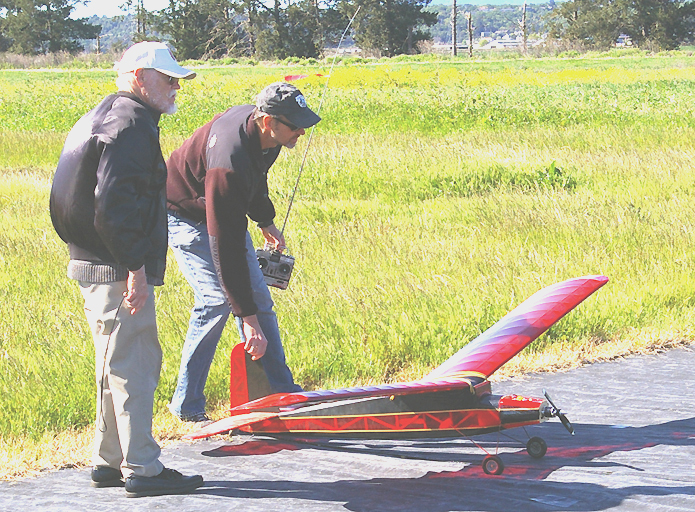 |
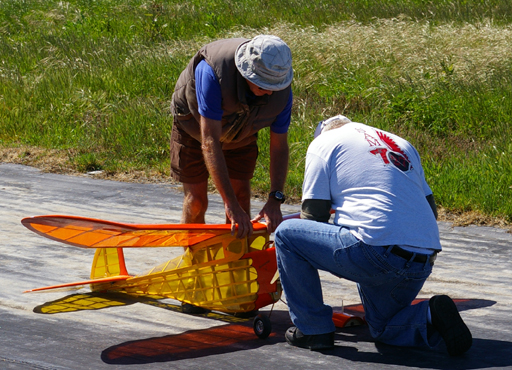 |
| Ed and Greg with the big Dallaire | Steve and Chip with the Rocketeer |
DEBREIFING SHEET (completed by all pilots)
See Debrief Sheet
Prefer reducing need for eagle vision Yes 4/5
Limiting altitude for powered climb Yes 5/5
Altitude Switches Most of the flyers used the CAM altitude switch for the first time and had no problems.
CAM switch experience good Yes 5/5
Fast Climb vs Slow and Majestic If there was no preference, both were counted.
Fast vs slow Yes 4/5.
Prefer precision target times to maxes Yes 4/5
Prefer points for takeoff vs hand-launch Yes 5/5
Prefer landing points Yes 4/5
Extra points for flying non-recent SAM Champs entry
to encourage building less frequently seen Old Timers
Yes 3/5
Fine tuning recommended for next contest
1) 15 landing points instead of 5, otherwise they are sacrificed to meet the target time.
2) 3,4,5,6,7 min rounds (Eliminate 2 min round, add 7 min)
3) Score is best 4 of 5 rounds (reduces bad luck)
4) First 3 rounds at 20 min intervals, starting at 9:30
May 17 Limited Altitude Meet Rules
Return Top of page